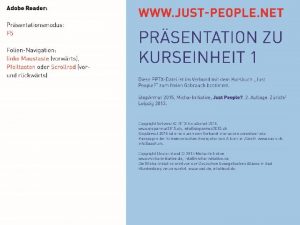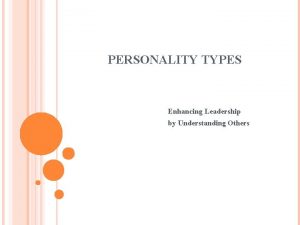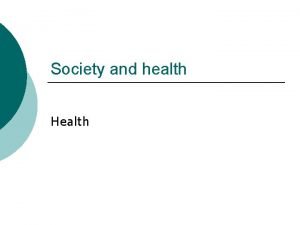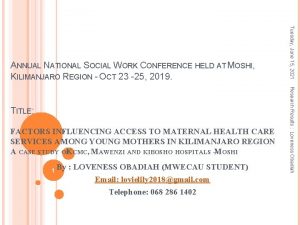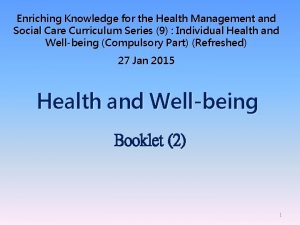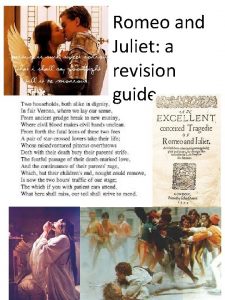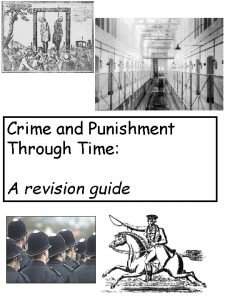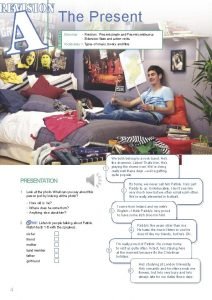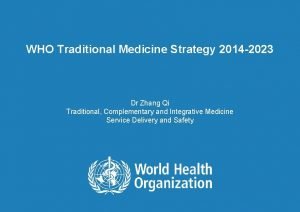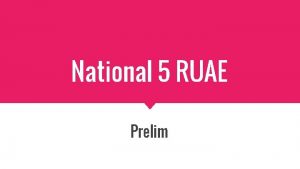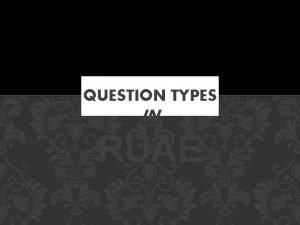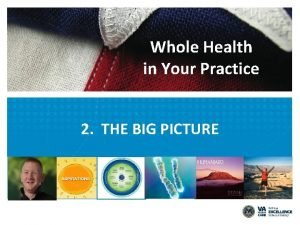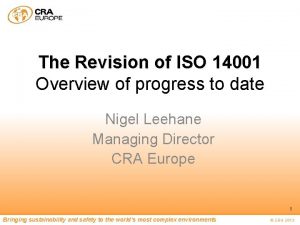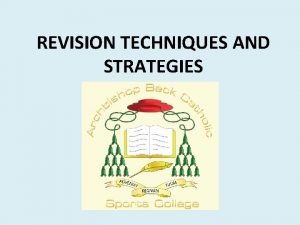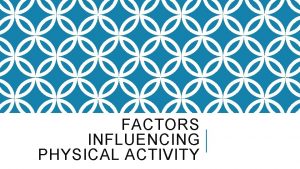Health and the people revision Factors Question types


































































































































- Slides: 130

Health and the people revision

Factors

Question types – Question 1 (8 marks) Source based – use source and own knowledge. Consider reliability and provenance (origin) Source A is useful for… because it says/shows… This is useful because I know that… However, it is not useful for telling us about (including specific relevant knowledge) The provenance of the source makes it more/less useful because… (Content, origin, purpose) Overall, source A is/isn’t useful because…

Question types – Question 2 (8 marks) Consequences of a development. Consider how significance has changed over time for top marks…… at the time, later, and today Explain what was significant about… in the development of medicine …was very/not very significant at the time because… …became more/less significant later because… …is now very/not very significant because…

Question types – Question 3 (8 marks) Consider two events and compare them to consider similarities or differences. Think about causes, events, developments and consequences. Compare x and y. in what ways were they similar/different? Explain your answer with reference to both. You should explain three factors The. . of X and Y were similar because they both… For example X… whereas Y… This makes them similar because…

Question types – Question 4 (16 marks) You need to draw on your knowledge from the whole course. You need to bring in understand from different periods. You will probably be asked about: understanding causes and cures; development of public health; development of surgery; development of medicines. You’ll be given one factor and you need to explain this factor and at least two others. Has… been the main factor of… in Britain since Medieval times? Explain your answer with reference to… and other factors.

Part 1 – Medicine stands still

Medieval Medicine • The course starts at the year AD 1000 BUT medicine during this time was based on the Ancient Greek, Hippocrates, and the Ancient Roman, Galen.

Can you explain why Hippocrates is regarded as such an important figure in the development of medicine?

Hippocrates – the 'father' of modern medicine Hippocrates and his followers firmly rejected magical and supernatural cures. He insisted that all diseases had physical causes. He encouraged doctors to observe symptoms and to look for causes based on those symptoms.

New Greek medical ideas As well as believing in the healing powers of Asclepius, there was also a lot of respect for other medical theories. One important Greek philosopher was Aristotle, who originally developed the Theory of the Four Humours which became the basis for Greek medical practice. Hippocrates developed theory further. Despite being wrong, it was a theory which was to be widely used by doctors for nearly 2, 000 years.

Source A: The four humours • Man's body has blood, phlegm, yellow bile and black bile. These make up his body and through them he feels illness or enjoys health. When all the humours are properly balanced and mingled, he feels the most perfect health. Illness occurs when one of the humours is in excess, or is reduced in amount, or is entirely missing from the body. • Hippocrates, 'On the Constitution of Man' (c. 500 BC)

The Theory of the Four Humours was influenced by Greek ideas about balance. The Greeks believed that the world was made up of four elements: Air Fire Earth Water Through observing the four seasons, they believed that each season must have a dominant element.

Each of the humours was related to a season and element: Air Fire Earth Water Spring Summer Autumn Winter Blood Yellow bile Black bile Phlegm

Greek doctors noted that patients’ symptoms varied with the seasons – heat rashes in summer, wet runny noses in winter. From this, they deduced that the human body was made up of four vital liquids which they referred to as ‘humours’: blood phlegm yellow bile black bile.

Galen and the Romans • We’ll flick over to the Boardworks powerpoint to find out more about the Romans

Factors in Ancient world • War – The Roman armies spread knowledge through the countries they conquered (including Britain!) • Individuals – Hippocrates and Galen • Religion – In all times religion banned dissection. Believed gods made you sick and made you better. • Education – The Greeks were great thinkers , they encouraged logical thinking and natural solutions to causes of illness. • Trade and Communication – as trade increased, there was an exchange of ideas. • Government – the Romans introduced public health into the towns.

Islamic medicine • After the fall of the Roman empire, much of their progress in medicine and public health was lost in the West – the ‘Dark Ages’. • Muslim writers saved much of this knowledge, translating manuscripts into Arabic, which eventually passed on to western Europe. • Islamic hospitals in the AD 900 s onwards were sites of medical education and healing. • The most famous hospitals, e. g. in Baghdad, Damascus, and Cairo, had lecture rooms, pharmacies, and libraries. • Many students received practical training and observed patients. • Cleanliness was encouraged. • Hospitals often centred around fountains, and cooling breezes circulated around the wards.

Other aspects • Public baths • Schools and universities • No dissection – religious rules • Thought diseases could be sent by Allah • Islamic texts told Muslim doctors to try and cure patients “Oh servant of Allah, use medicine. Allah has not created pain without a remedy for it. ” • Charity and caring = important in Islam • Cairo hospital AD 1283, patients given money when they left so didn’t have to go straight back to work

Surgery • Still used idea of four humours and clinical observation • They invented distillation to prepare drugs for treating diseases and anaesthetics e. g. soaking a sponge in hashish and opium – put on patient’s face or two pieces in nostrils • Doctors had to train and get a licence, then he could have his own medical practice or work in a hospital • However, people who worked as healers didn’t have a licence but could still work • Surgery is a last resort • Emphasise knowing what is causing pain before operating. Have a plan and equipment and anaesthetics • More prepared to do surgery that didn’t involve opening the body e. g. cataracts, setting fractures etc • Dentistry – more careful and skilled and made artificial teeth from bone

Medieval medicine – believed causes • God – illness was punishment for sin. An epidemic (widespread disease e. g. the plague) was punishing society • God could cure disease and also provided right herbs or plants to treat it • Bad smells (miasmas). Mortality was higher in towns and cities because of close living quarters • Everyday life – many children died before 7 years old • Childbirth was very dangerous • Supernatural – witchcraft was feared. Belief in demons. • Four Humours – widest-held belief.

Medieval medicine – practitioners • Barber surgeon – minor operations, set broken bones, pull teeth. They served an apprenticeship before qualifying. Mostly in towns and cities but some travelled in the countryside and visiting fairs. • Apothecary – sell medicines, herbs, and spices. Apprentieship for seven years. Simples = medicine of one herb or plant. Compounds = combination. • Wise woman – wisdom and skills handed down, reasonably priced, usually knew the patient. Also acted as midwife. • ‘Lady of the house’ provided medical care for the family and labourers. • Trained doctors = hugely expensive.

Medieval surgery • Two groups: 1) University trained and licensed BUT very expensive 2) Barber surgeon – unqualified BUT cheaper Both groups had limited anatomical knowledge due to dissection being limited or forbidden No knowledge of germs so patients die often from blood loss or infection.

Diagnosis and treatment • Doctors would use urine charts to diagnose patients, they test the colour, smell and even taste of the urine. • Zodiac charts – parts of the body linked to astrological sign, so what would be needed to cure a patient. E. g. some things work for an Aries but not a Pisces. It might also tell the physician the best time to treat, and even when to pick the herbs. • They still believed in theory of opposites (Galen) and so would use methods such as bleeding to balance the humours. • There was a huge selection of herbal remedies. Many of these have been proven to work e. g. onion and garlic kill bacteria. • There were also supernatural treatments available, such as charms and The King’s Touch (when the king would touch a person that was suffering with the disease scrofula to cure them)

Important individual – John Arderne • Born 1307 Trained as a surgeon and practised in London • Famous for his success rate • E. g. removing growths from inside an anus had a survival rate of over 50% - massive for medieval times • Worked as a surgeon on the battlefield • Pain killing ointment – hemlock, opium, and henbane • Speedy amputation skills • Book – the Practice of Surgery, 1350 • Advocated good bedside manner • Told doctors to trust own judgement • Charged the rich as much as he could but treated the poor free.

Church’s role – help and hinder Help Set up 160 hospitals in 12 th and 13 th centuries Set up university schools of medicine Preserved knowledge by copying books Monks and friars acted as doctors Treated the poor free Hinder Dissection limited if not forbidden Insistence on using Galen Emphasised prayer and pilgrimage over scientific treatment Tried to control knowledge – arrest people spreading anti-Church ideas

Medieval hospitals and public health

Monasteries Own water and drainage supplies Dirty water used to clear toilets Water for drinking was purified many times Monks emphasised hygiene One monk would be in charge of clean towels and sheets. Hospitals Set up for different reasons e. g. poor, pregnant women (St Bartholomew's in London) or ‘poor and silly persons’ (St Mary’s) Leper houses Catered to poor Most were care homes rather than treatment Towns Crowded and dirty Water came from river but this had rubbish and sewage in it Cesspits emptied into river Some passed law to stop people throwing rubbish and sewage but this was hard to enforce Animals everywhere Most drank beer rather than water

Factors – medieval medicine War – Armies took trained doctors to war so they gained experience on the battlefield. However war also made travel dangerous and caused the collapse of the public health system. Religion – The Christian church set up universities for doctors to train in. It also built hospitals. They also housed books in the monasteries. However, the universities did not teach the doctors to look for new ideas as they said Galen’s ideas were correct. Communications –The Crusades led to an exchange of ideas with Arab doctors. Government – There were some laws to force towns and cities to clean up. However, these were not enforced and the King had not money to pay for improvements.

The Black Death • In 1348, a ship brought the Black Death to England. Over 40% of the population died during the plague. The Black Death killed both rich and poor alike, swiftly and painfully. The dead were quickly buried in large communal graves. • There were two kinds of plague: • Bubonic Plague • Pneumonic Plague •

A Case Study of the Black Death – 1348 -49 https: //www. youtube. com/watch? v=Lv 0 d. Kdhd. Rp. M Causes – Use the Blue Book Cures – Use the Blue Book • Miasmas • Four Humours out of balance • God • Jews poisoning wells and springs • Planets • Earthquake in China • Pop open buboes • Attach a live chicken or pigeon • Drink vinegar and mercury • Flagellation (whip yourself) • Bleeding • Pray Avoiding infection egs include praying, clean up filth, bathe in urine 25/11/2020

Plague – similarities and differences 14 th • • • Century (1300 s) March and pray Burning candles Avoid eating too much Avoid taking baths Avoid having sex (excitement will weaken you!) Avoid all plague victims Clean all filth Carry sweet smelling herbs and spices to keep away evil smells Attend church Bathe in urine three times a day or drink it once a day 17 th Century (1665 -1666) • • • Stop all public entertainment Pigs and other animals not kept in the city Kill all dogs and cats Clear rubbish from the streets Light fires in the streets to drive away miasmas Houses containing plague victims are to be sealed up for 40 days and the door painted with a red cross No strangers in the city without a certificate of health Bodies buried after dark and not in churches or churchyards Public prayers on Wednesday and Fridays Weekly fasts (going without food)

Exam checkpoint • Source A: showing Saint Elizabeth of Hungary, who was famous in the 13 th Century for helping the poor and sick. • How useful is it for understanding Christian ideas about illness? Explain your answer using Source A and contextual knowledge.

Exam checkpoint • Source B: illustration in a 14 th century book written by an abbot, recording the impact of the Black Death. • How useful is it to an historian studying the impact of the Black Death in England? Explain your answer using Source B and contextual knowledge.

Exam checkpoint • Compare public health in a medieval town with public health in a medieval monastery. In what ways were they different? (8 marks – q 3 type).

The Renaissance • The Renaissance gets its name from the rebirth in interest of the classical period. • The Royal Society (a famous scientific society), was founded in this period (1660). The Renaissance saw science begin to replace explanations of superstition, astrology and religion. • Renaissance Man is important as people at the time thought that a welleducated person should have a good knowledge of science and art. Artists like Michelangelo and Da Vinci would have studied both. They would attend dissections resulting in wonderful drawings. • The return of the works of Galen and Hippocrates renewed a belief in the four humours, treatment of opposites and various herbal remedies.

Andreas Vesalius • http: //www. bbc. co. uk/education/clips/z 63 n 34 j • Vesalius was born in 1514 and studied medicine in Paris and Italy. He was allowed to perform dissections but couldn’t look closely at the skeleton. He was so dedicated he stole the body of a criminal from the gallows. • He became professor of surgery at Padua in Italy where he performed more dissections. He wrote books on his observations including The Fabric of the Human Body in 1543. • His illustrations were carefully labelled and he used his powers of observation to point out some of Galen’s mistakes. • Galen thought that blood passed through the septum of the heart through little holes. Vesalius proved there were no holes in the Septum. • Galen believed that human jaw bones were made of two pieces. Vesalius proved it was one. • This was important as it proved Galen could be wrong!

Ambroise Pare • Pare was a barber surgeon born in 1510. Surgery was still a low status profession. He first worked for a public hospital and then became an army surgeon. • At the time the wound left by amputation was sealed by burning the end with a red hot iron, known as cauterisation. This was very painful. • Pare invented the method of tying off vessels with thread, known as ligatures. This was less painful, but may have caused infection as they did not yet know about germs. • Gunshot wounds were, at the time, treated by pouring boiling oil into the wound. • During one battle, Pare ran out of oil and resorted to an ointment of his own. To his surprise, these patients recovered better than the ones scalded with oil. • He received opposition to his ideas from doctors who didn’t want to listen to a lowly surgeon. However, when he became surgeon to the King of France and gained the King’s support, people started listening to his ideas.

William Harvey • William Harvey was born in 1578 and studied medicine in Padua in Italy. He then worked in London as a doctor and lecturer to James I and Charles I. • He realised he could observe living animal hearts in action and his findings would also apply to humans. He chose cold-blooded animal so the heart beat was slow. • In 1628, he published a book showing that blood was going around and NOT being used up and remade like Galen thought. He also proved the difference between arteries and veins. • Although Harvey’s discovery was useful for knowledge of anatomy and for challenging Galen, it did not radically change surgery. Bleeding continued to be performed and blood transfusions were not generally successful until the discovery of blood groups in 1900.

Thomas Sydenham – the English Hippocrates Believed in close observation of the patient and monitor symptoms and treatments given, in order to build up a body of knowledge and experience. Some praised his efforts, but most thought him eccentric. Treatment for smallpox = ‘cool therapy’ – lots of fluids, moderate bleeding, keeping patient as cool as possible.

Printing • Johann Gutenburg introduced printing to Europe in 1454. This invention helped medicine progress! William Caxton set up the first British printing press in 1476 in Westminster Abbey. • Making a single copy by hand could take weeks, months, even years to complete by a copyist. Books were therefore very rare before printing. New ideas could not be spread easily as they just weren’t written down anywhere! • The printing press changed this, and was a big factor in helping new ideas spread within the Renaissance.

Changes in medicine • The discoveries made by Harvey and Vesalius were important as they proved to doctors that Galen was wrong and that careful dissection and experimentation were the way to new ideas. • Pare’s use of bandaging wounds and using ointment instead of boling oil helped patients survive as other surgeons could see it working. However his use of ligatures slowed down surgery, causing problems with bleeding, and also helped spread infection as these were not sterilised. • In 1492, America was discovered. This brought a wide range of new knowledge to Europe including many new herbal treatments. Trade and communication helped here.

Continuity in medicine • The discoveries of Harvey and Vesalius did not make anyone healthier at the time. Life expectancy did not increase much. They hadn’t discovered new and better ways of treating illnesses. • Treatments: Herbal remedies were still widely used. It is important to remember that a number of these worked. Surgery only improved a little. • Treatments from the Four Humours were still widely used; this had not yet been disproved. • Superstitious treatments were still widely used, including charms and the famous ‘King’s Evil’, this included the king touching someone with the skindisease, Scrofula, in order to cure them. • Trained doctors and surgeons could still treat those who could pay. The poor had to rely on family, wise women and travelling quacks.

Exam checkpoint • Compare medieval anatomy with Renaissance anatomy. In what ways were they different? Q 3 type, 8 marks

John Hunter Surgeon and anatomist What did he spend most of his time doing? Training surgeons and dissecting bodies. http: //www. bbc. co. uk/education/clips/zcrhn 39 Some pictures may be upsetting. What was ‘Burking’? Named after William Burke and William Hre who committed ten murders in a few months in order to sell fresh bodies to surgeons and schools of anatomy. Why was John Hunter accused of Burking? He always seemed to have fresh supplies of bodies!

Changes in surgery • Royal College of Surgeons set up in the 1800 s • Could only practice with a license • 1811 – had to attend at least one course in anatomy and one in surgery • 1813 – minimum one year’s experience in a hospital

Technical and Scientific advances • The microscope was invented in 1683 by Antony Van Leeuwenhoek. • The thermometer was invented by Daniel Gabriel Fahrenheit in 1709. • Physicians such as Hermann Boerhaave were stimulated into observing patients more closely and keeping accurate records. • Albrecht Von Haller, a student of Boerhaave’s investigated breathing and digestion. • Yet none of this resulted in doctors discovering the real cause of disease.

‘Quackery’ • ‘Quack’ doctors in search of profit, peddled all sorts of nonsense cures. • For example, ‘piss prophets’ emphasised diagnosis by examining urine. • Others recommended useless pills or claimed that evil worms caused illness. • A German doctor Franz Mesmer claimed he could cure patients through hypnotism. • The main reason people bought from quack doctors? Desperation. • Main incredient in quack medicines was alcohol and opium.

Growth of hospitals • Thomas Coram opened a hospital in 1741 to acre for abandoned children – spent 10 years collecting funds • Babies chosen by lottery • Most were 5 -15 and then trained for domestic or military service • Voluntary hospitals filled the gap left by abolition of monasteries. Began to treat the sick properly.

Factors • Individuals: People were willing to challenge old ideas. By experimenting they could prove they were correct. • Wars: Public health was made worse but developed knowledge of anatomy and treatment • Education: literacy was increasing and there were more schools. • Technology: printing helped with the spread of ideas; there were improvements in clocks, watches and pumps; more realistic artwork. • Ancient learning: renewed interest in the writings of Greek/Roman thinkers.

Exam checkpoint • Compare the work of Andreas Vesalius and John Hunter. In what ways were they similar? (8 marks q 3) • Explain the significance of the work of William Harvey for the development of surgery. (8 marks q 2)

Smallpox • Smallpox was a big killer in the 18 th century. If you survived the disease you were left badly scarred. • Lady Montagu learnt about inoculation in Turkey and introduced it to Britain. This was when pus from a sore of someone with mild smallpox was given in a small cut to the person being inoculated. After a mild reaction, they were immune to smallpox. • Unfortunately inoculation sometimes led to full blown smallpox and death. • However, as people feared smallpox, they took the risk. Doctors were made rich from this.

Edward Jenner • Jenner (b. 1749) was a country doctor. He heard that milkmaids didn’t get smallpox, but they did catch the much milder cowpox. • Using his skills of experimentation and observation, he found that this was true. • In 1796, he tested his theory on a boy called James Phipps. He injected him with pus from a milkmaid who had cowpox. Jenner then injected him with smallpox but he didn’t catch the disease. • The Latin for the word cow, vacca, gives us the word vaccination.

Opposition • In 1840, vaccination was made free for infants, and compulsory in 1853. (The first time any government had forced a medical treatment on the entire population) • Some people opposed the vaccination. Reasons were varied and include: • Doctors who were making money out of inoculation didn’t want to lose their income. • Jenner couldn’t explain why it worked and some people didn’t believe a disease that came from cows could protect you. • Vaccination was seen as dangerous. Not all doctors were careful with the dosages. • Some people did not like government forcing medicine upon them.

Change and continuity • Doctors: From the 1750 s ordinary people were able to call on the services of a local doctor or general practitioner after they trained in an apprenticeship. They would often waive the fees of the poor who were unable to pay. • But the cost of medicine was a problem. Dispensaries began to appear. These were created to provide the poor with cheap medicine. • Many illnesses were still treated in the home using common sense and herbal treatments. • There was also a rise in ‘Patent Medicines’ which claimed to cure all. There were some dangerous ingredients in a number of these.

Women • Due to a number of changes, the role of women in medicine had gradually reduced: • In the middle ages, the Church allowed only men to train as physician. • By 1700, surgeons also had to have a university degree. As women could not go to university, they were unable to become surgeons. • With the introduction of medical forceps. Midwifery also was taken over by men. • In 1852, there was the Medical Registration Act which required all doctors to belong to one of the College of Physicians, Surgeons or Apothecaries. All of these were closed to women. • Some women did fight to overcome this. Elizabeth Garrett was the first woman to qualify as a doctor in Britain. • Women still played a major role as healers in the home, and as nurses. In the 1850 s, female nurses went to work in the Crimea. This was the first time women were used as army nurses.

Nursing • Florence Nightingale became a nurse despite opposition from her family. • When the Crimean War broke out in March 1854, horror stories emerged about the hospitals that were treating the wounded British soldiers. • The secretary of war, who was a friend of the Nightingale family, asked Florence to go and sort out the nursing care in the hospitals over there. Florence took 38 hand-picked nurses and made changes such as bringing in good food and boiling the sheets. The death rate in Scutari hospital was 42% before she arrived, and 2% afterwards. • When she returned, she set up the Nightingale School of Nursing and wrote her book ‘Notes on Nursing’ which became the standard textbook. • Men were not admitted onto the Royal College of Nurses until 1960.

Nursing – Mary Seacole • Mary Seacole learnt nursing from her mother, who ran a boarding house for invalid soldiers in Jamaica. She came to England to volunteer for the Crimea. • She was rejected, probably due to racism, but raised money to make her own way. • She nursed soldiers on the battlefield and was loved by many. However, when she returned to England she was unable to find any work and went bankrupt.

Scientific breakthroughs

Germ theory • Micro-organisms had been seen through 18 th century microscopes but scientists thought that they were caused by disease and appeared because of illness. This was theory of spontaneous generation. Instead of blaming the micro-organisms, they blamed bad smells or miasmas. • Louis Pasteur was employed in 1857 to find out why alcohol was going bad in a brewing company. His answer was to blame germs in the air. Pasteur proved this and showed how to kill these germs by boiling the liquid. • Pasteur was a scientist, not a doctor, and he carried out his early experiments with beer, wine and silkworms.

Robert Koch, 1843– 1910 Click REVEAL to find out about the work of Robert Koch. I am German. I am a rival of Pasteur, but am using his work to develop my own work. In the laboratory I can link particular germs to particular diseases. In 1882 I identified the specific bacillus (bacteria that cause disease) that caused tuberculosis (known as TB). In 1883 and 1884 I identified the bacillus responsible for cholera. My students and I found the causes of many diseases such as diphtheria, typhoid, pneumonia, plague, tetanus and whooping cough, all of which are killer diseases in Britain. REVEAL RESET

Robert Koch • Koch began to study different microbes (germs) to see which microbe caused what disease. He developed a solid medium to colour microbes, and dyeing techniques to colour them. • He managed to identify the anthrax microbe in 1875, linking germs to human disease.

Rivalries • Pasteur (French) and Koch (German) were rivals at this point. France had lost a war to Germany in 1870 -71 and it bothered Pasteur that Koch appeared to be getting ahead on the medical front. • Pasteur joined the race to find cures for anthrax and chicken cholera. Both he and Koch had been given large teams to help them. • In the summer of 1879, some chicken cholera solution was accidentally left out over the holiday. On the return of the team, this was injected into a number of chickens. The chickens survived, they then tried with some new cholera, but the chickens still lived. • They worked out that the cholera had been weakened by its time out in the open, and that this weakened cholera had made the chickens immune (like Jenner’s vaccination)! • The cure for anthrax followed in 1881, then rabies in 1882.

Paul Ehrlich, 1854– 1915 Click REVEAL to find out about the work of Paul Ehrlich. I am one of Koch’s students, I love using science to prove the causes of disease. In 1910 I developed Salvarsan 606 which was the first effective treatment for syphilis – we called it 606 as it was the 606 th drug we used to try to kill the disease. It is our lucky number! We called these drugs ’magic bullets’, as they are carefully designed to target the specific germ causing the illness and have no effect on any other part of the human body. REVEAL RESET

Developments in surgery - anaesthetics • The use of natural drugs like alcohol and opium to reduce pain had been around for a while. But these were not very effective and could make the patient ill. • Laughing Gas was introduced by Humphry Davy in 1799, but it did not work on all patients. • Ether was introduced in the 1840 s but this was an irritant and also fairly explosive. • In 1847, James Simpson was ‘testing’ some drugs and discovered that chloroform was an effective anaesthetic. It then started to be used in surgery.

James Simpson, 1811– 70 Click REVEAL to find out about the work of James Simpson. But if too much is used patients can fall unconscious. In 1847 I used chloroform to reduce pain in childbirth. It is an anaesthetic to reduce pain. But in 1853 Queen Victoria herself used chloroform in childbirth and it then became very popular, hoorah! Many people opposed me as it was difficult to get the dose right in operations. REVEAL RESET

It was difficult to get the dosage right with early painkillers. Limitations Anaesthetics did not necessarily make operations safer Still no control over infection. Surgeons tried more difficult operations because they could take longer to operate, but… Some surgeons had higher mortality rates using anaesthetics. In the 1870 s, some stopped using chloroform altogether.

1. Some people objected to its usage on religious grounds. Others were afraid of the dangers of an overdose 2. Surgeons could perform more complicated surgery. As infection and bleeding were still a problem, this actually led to more deaths. 3. It was hard to get the balance right; some patients were paralysed by the drug, whereas others could still feel the pain.

What is happening here? What is being sprayed? Why would this help? What might the impact be? RESET

Joseph Lister – a revolutionary? • http: //www. bbc. co. uk/education/clips/zfhnvcw

Joseph Lister, 1827– 1912 Click REVEAL to find out about the work of Joseph Lister. My surgical instruments were sterilised with carbolic acid too to reduce infection. After I found out about germ theory I used an operating room sterilised with carbolic acid. I soaked the wound from time to time with carbolic acid and used dressings sterilised in exactly the same way. By doing this I reduced the mortality rate in my operations from 46 per cent to 15 per cent in only three years, which was quite remarkable! In 1871 I had invented a machine that sprayed carbolic acid over the entire room, surgeon, patients, assistants, everything was covered in the spray. I became known as the ‘father of antiseptic surgery’. REVEAL RESET

Antiseptic and aseptic surgery Koch discovered in 1878 that most disease was spread not by air but by contact with infected surfaces. This led to attempts to The biggest killer after surgery was William Halsted in America started his Listerilised his operating theatre create a germ-free environment. In 1881 a sepsis infection, otherwise known as team wearing surgical gloves because and utensils with carbolic acid, which Sepsis Koch’s work steam steriliser was invented for medical hospital gangrene, an infection caught one of his nurses developed a greatly reduced the mortality rate in instruments. Next step was a sterile during or after an operation. reaction to the carbolic spray. operating theatres. operating theatre where staff were Antiseptic and aseptic surgery scrubbed and the air sterilised before they Halsted’s work Lister’s work entered. Antiseptic: Something that stops disease-spreading organisms growing and spreading in the body. Aseptic: Sterile, or totally free from contamination by viruses or disease-spreading organisms. Click on each part of the diagram to find out more. CLOSE

Topic Summary • Over 40% of patients died as a result of operations. • The surgical profession was dominated by men. • James Simpson developed the first effective anaesthetic (chloroform), making surgery safer. • Joseph Lister developed the use of antiseptics in preventing hospital gangrene. • Aseptic sterile surgery made a huge difference to survival rates. • Many surgeons opposed the changes. • In some hospitals, change was slow to happen.

Exam checkpoint • Q 2 Explain the significance of lister’s work for the development of medicine • Q 3 Compare the work of Pasteur and Koch. In what ways were they different? • Compare surgery in the Middle Ages with surgery at the time of John Hunter. In what ways were they similar? Q 3

How has war impacted medicine? • During the First World War, more people were killed and wounded than in any previous war. New and deadly weapons were used for the first time, such as shrapnel bombs and high-explosive shells. They caused terrible injuries that surgeons had never seen before. • However, this caused a number of improvements in medicine and health: • Surgery improved – they had opportunities to experiment with new techniques. These included developing new techniques to repair broken bones, and to perform skin grafts (the start of plastic surgery). • X-rays were discovered before the war. During the war, they were used to find bullets and shrapnel lodged in the body. Governments paid for more and more X-ray machines to be made. • Blood transfusion was used effectively for the first time after blood types were discovered in 1900. Methods of storing blood and transporting it were improved. • The poor health recruits to the army made the government very worried about their living conditions at home. The soldiers who fought in the war were promised ‘homes fit for heroes’ when they returned. This caused unhealthy slum houses to be knocked down.

Second World War • The second world war improved medicine by: • Further improvements in blood transfusions. Including better ways to store blood and the introduction of donations of blood from civilians. • Rationing was introduced to improve some people’s diet and healthy eating was encouraged through government posters. • Penicillin was developed – the first antibiotic. • Further improvements in the use of skin grafts and in the treatment of burns by surgeons. • 1. 5 million children were moved from the cities into the countryside for their safety. This showed how much difference there was between the rich and the poor. The government became more serious about fighting poverty. • The government improved what services the poor people could access. In 1942, William Beveridge, a civil servant, put forward the idea of a ‘free national health service’ for all.

The development of penicillin • Penicillin – an antibiotic that kills bacteria or prevents it from growing. Effective against a wide range of germs.

What is Penicillin? Penicillin is an antibiotic. ‘Antibiotic’ literally means ‘against life’ – but antibiotics only kill life that is harmful to living creatures, i. e. bacteria. A bacterial infection is caused by millions of tiny bacteria that are trying to survive and multiply in the body. An antibiotic attacks and kills these bacteria. Before the development of penicillin, many people suffered and died from bacterial infections that are no longer considered dangerous today.

So did Fleming actually discover penicillin? Penicillin is made from a mould called penicillium. This mould was first discovered in the early 19 th century by John Sanderson who found that very little grew near it. In the 1880 s, Joseph Lister noted these observations and wrote to his brother to say that he intended to try penicillin on infected wounds. Lister successfully treated a nurse with an infected wound with penicillin, but did not leave any notes on the case and apparently did not continue his research in this area.

Who was Alexander Fleming? Alexander Fleming was born in Ayrshire, Scotland, in 1881. He was the son of a farmer. When he was 13, he moved to London to live with his older brother. After graduating from the University of London, he became a bacteriologist at St. Mary’s Hospital in the city.

The great re-discovery of penicillin! It was in the laboratory of St. Mary’s Hospital in 1928 that Fleming rediscovered the properties of penicillin. This source comes from a biography, The Life of Sir Alexander Fleming, written in 1963. It describes when Fleming was visited by his friend, Pryce. Turn to your list of factors. ‘Fleming was in his little laboratory as usual, surrounded by Which factor contributed to the discovery of innumerable dishes. The cautious Scot disliked being separated from his penicillin? cultures before he was quite sure there was nothing more to be learned from them. . . Fleming took up several old cultures and removed the lids. Several of the containers had been contaminated with mould. . . ‘As soon as you uncover a culture dish, ’ he said to Pryce, ‘something tiresome is sure to happen. Things fall out of the air. ’ Suddenly he stopped talking, then, after a moment’s observation, said. . . ‘That’s funny. . . ’ On the cultures at which he was looking there was a growth of mould, as on several of the others, but on this particular one, all around the mould, the colonies of staphylococci had been dissolved. . . ’

So what did the mould look like? The mould Penicillium Notatum, shown growing in a Petri dish, and in close-up

How had it got into Fleming’s dish? • On investigation, Fleming found that penicillin spores had got on to the dish, perhaps blown into his lab through an open window. The penicillin was killing the staphylococci. • Whether the account we just read it how it really happened, we cannot be sure – even Fleming’s own accounts of how it happened varied! • The important point is that Fleming identified the mould and saw its significance – that penicillin could be applied to or injected into areas where there were penicillin-sensitive microbes. • However, Fleming did not have the facilities or the support to develop and test his idea that penicillin could fight infection.

1. What is penicillin? 2. What part did chance play in the discovery of penicillin? 3. http: //www. bbc. co. uk/education/clips/ zd 2 qxnb

Think! • Why is Fleming usually thought of as the discoverer of penicillin? (not inventor – penicillin is a natural substance) • Why do you think that so many people observed the power of penicillin but did not develop it as a cure?

Florey and Chain It was the Second World War which finally brought about the successful development of penicillin. In the 1930 s two Oxford scientists, Howard Florey and Ernst Chain, became interested in Fleming’s 1929 paper on penicillin. In 1939 they assembled a team of pathologists, chemists and biochemists, and three days after the outbreak of war Florey asked the British government for money to fund the team’s research into penicillin. Howard Florey (left) and Ernst Chain.

Their contribution? • Developed a method of making pure penicillin from mould juice • Tested it successfully in 1940 first on mice and then on a policeman, Albert Alexander • But unable to make large amounts and so Florey went to America to try to persuade chemical firms to invest in his ideas • Unsuccessful at first

Production continues. . . but not in great quantities! Although this first patient still died, it was clear that penicillin was a powerful drug. Production remained painfully slow, but as new batches were produced, two more patients were successfully treated. In August 1942, Fleming himself used penicillin to successfully treat a friend who had meningitis. But the war was producing thousands of casualties – penicillin needed to be mass produced if lives were to be saved.

How important was penicillin? • It is estimated that without penicillin, another 12 -15 per cent of wounded Allied soldiers would have died of infections. • Penicillin also roughly halved the average time the Allied wounded spent in hospital.

How important was penicillin? • Penicillin was a miracle drug when it was first developed. It could treat a wide range of infections and diseases. In 1945, Fleming, Florey and Chain were jointly awarded the Nobel Prize for Medicine for their work on penicillin.

Important individuals in surgery • John Arderne – first English surgeon (wrote The Practice of Surgery in 1350) • James Simpson – pioneer of anaesthetics (introduced chloroform in 1857 – even Queen Victoria used it in 1853 when giving birth!) • Ambroise Pare – pioneered use of ligatures instead of cauterisation to stop bleeding (published his findings in 1575) • Alexander Gordon – reduced death from infection by washing hands and clothes in chlorinated water (published results in 1795) • William Cheselden – did quick operations before the days of anaesthetics (1720 s – could remove bladder stones in under a minute!)

Important individuals in surgery • Harold Gillies – pioneer in plastic surgery during WW 1 • Joseph Lister – pioneer of antiseptics – used carbolic acid to sterilise surgical instruments, dressings, and clothes. In three years, his mortality rates reduced from 46% to 15%. Invented a carbolic acid spray machine in 1871. • Archibald Mc. Indoe – Second World War – improved on Gillies’ techniques for skin grafting.

Exam checkpoint • Explain the significance of anaesthetics in the development of medicine • Explain the significance of penicillin in the development of medicine • Q 2 type

Public Health

Were Industrial Towns really that bad? • Bethnal Green, east London: in 1842, the life expectancy was 45 years old for rich people, and 16 years old for labourers (working class). • In Manchester, 57% of children died before their fifth birthday. • Families often lived in one room, or a cellar liable to flooding. • Many children shared a bed. • Toilets and water pumps shared by many families.

Industrial diseases • Scrotal cancer in chimney boys from soot and gases. • ‘Phossy-jaw’ – girls who made matches would have their jaws eaten away by the phosphorous. • Brain damage • Coal miners developed pneumoconiosis, a lung disease. • Factory workers would often have limbs damaged.

Did they really do that? ? • Bakers added powdered chalk to flour • Dairies watered down milk and then added chalk powder to make it look white again. • One man made ‘chocolate’ by mixing brown paint with melted candle wax – and sold it to children! • The same man took sugar sweepings from the floor of a shopkeeper and boiled it to make toffee.

Contagious diseases • Typhoid • Typhus • Diarrhoea • Smallpox • Tuberculosis • Scarlet fever • Whooping cough • Measles • Chickenpox • Rickets (bone disease common in children suffering from calcium deficiency)

Why wasn’t anything being done? Vested interests Germ Theory wasn’t yet accepted by doctors. Governments weren’t expected to improve living/work conditions. No pension or welfare. Working conditions very poor and long hours. No health and safety measures. Doctors charged patients – poor couldn’t afford it. Workers lived near to work. Fresh food was hard to get into towns and very expensive. Landlords made profits from renting out houses built quickly and cheaply. People should help themselves. Some objected to government interference.

Edwin Chadwick • 1842 – wrote a report about the working class in London. Convinced that sickness was the cause of poverty. Argued that in order to increase England’s productivity, the poor and working class must be helped.

Click REVEAL to find out how John Snow discovered the causes of cholera. In 1849 after the 1848 cholera epidemic, I published a book to show cholera was spread by dirty water rather than air. I later discovered that a cess pit one metre away from the water pump was leaking dirty water into the water supply. In 1854 in the first ten days of a cholera outbreak over 700 people died in my locality. Medical opinion ignored my findings. JOHN SNOW I got permission to remove the handle of the water pump and this forced people to collect water from elsewhere. Immediately the disease abated in Broad Street. REVEAL RESET I carefully mapped the location of each death and concluded that they had all collected their water from the pump in Broad Street. I also noticed that beer drinkers from a nearby brewery who drank beer rather than water did not fall victim to cholera.

1848 ● Encouraged local authorities to improve conditions in their area, e. g. to improve drainage and sewers, inspect slaughterhouses and levy a rate to pay for these changes. ● Allowed authorities to borrow money to make these improvements. 1875 ● Local councils had to provide clean water. ● Local councils had to provide proper drainage and sewers. ● Local councils had to appoint Medical Officers of Health. ● A general Board of Health was established. ● Authorities could appoint Medical Officers of Health. 2, 500 miles of new earthenware pipes were laid. Public health issues were kept in the public eye. It was an optional act, not compulsory. Many local authorities refused to set up boards. By 1853, only one-sixth of the population was covered by a board. The new sewer pipes were easily blocked. Chadwick was a difficult man and made many enemies. It was compulsory. Led to much cleaner towns and cities. End of the policy of laissez-faire – councils had to take responsibility. Hundreds of thousands of people still lived in poverty and had terrible living conditions. Infant mortality started to rise around 1900.

How did technology make the Clean Up possible? • https: //www. youtube. com/watch? v=_q. Aii 3_MAe. I • What did Joseph Bazalgette do? • What other inventions helped? • When and why was tax taken off soap?

Exam checkpoint • How useful is source D to an historian studying public health problems in Britain?

Modern medicine


The Age of Pills • As new antibiotics and other medicines were produced, doctors were bombarded with literature about new drugs and free samples. • Because new pills could make the producers rich, companies took shortcuts or didn’t test the drugs properly before distribution. • One example is thalidomide – a sleeping pill introduced in the 1950 s, advertised as safe for pregnant women. • Thousands of babies were born with malformed limbs. • It wasn’t until 1962 that the link was made. • The German manufacturer and British licensee agreed to compensate victims. • A positive outcome was setting up much tougher testing for new drugs.

A growing belief in alternative medicines Study the image and discuss the following in pairs: • What are the similarities between this image and the Ancient Greek theory of the Four Humours? • Why do some people distrust modern medicine? • Can you think why alternative medicine is becoming more popular in the modern age? How one organisation promotes the idea of holistic medicine in the twenty-first century.

Alternative medicine • The Thalidomide scandal made some people distrust orthodox medicine and go to alternative medicine – known as HOLISTIC medicine. • This is based on old, traditional treatment using herbs that work in harmony with the body. • Treatments include hydrotherapy, aromatherapy, hypnotherapy and acupuncture. • There are some big supporters, like Prince Charles. • However, the British Medical Association call it “witchcraft” and senior advisers to the government call it “nonsense”. • The evidence is conflicting but alternative medicine is appealing to those who don’t wish to fill the body with chemicals.

X-ray units Better id of items inside bodies of injured soldiers Shell shock Treatment Talking cure, healthy sports and craft. 80, 000 men diagnosed between 1914 -1918 Blood transfusions Pioneered by British Army, by 1917 blood was being stockpiled New technology Skin grafts Harold Gillies developed new techniques. Over 5000 treated by him. Enabled him to reconstruct faces. Was knighted after the war.

Rapid development and change • 1952 – the first Kidney Transplant • 1961 – first pacemaker fitted (a mechanical device that keeps the heart pumping blood) • 1967 – the first heart transplant (this took place in South Africa) • 1972 – hip replacements • 1978 – “Test-tube” babies (IVF)

Commonplace Treatments In 2014, there were 181 heart transplants in England alone. Keyhole surgery (surgery involving a very small cut) Laser treatment (e. g. for cancer and eye operations) makes surgery less invasive and quicker healing times. CAT scans, MRI scans and endoscopes (tubes with tiny cameras) allow surgeons to see inside DNA discovery in 1953 allow medical professionals to understand the body more preventative measures.

Modern anaesthetics

Focus • During the 20 th Century, the government’s role massively shifted. • Once, it was a laissez-faire attitude – now, it is actively involved in ensuring the health of the population. • However, the extent of the role is up for debate, not least between the major political parties. • Changes in poverty and housing in post-war Britain led to the creation of the NHS – taking care of people from ‘cradle to grave’. • We will look at the costs involved in modern-day healthcare, differences in treatment, and out responsibilities as users of this system.

Identifying the problem • The Boer War was fought in South Africa, 1899 to 1902. • 40% of the volunteers for the British army were in such a poor state of health that living conditions and health of the poor in industrial cities were investigated. • Workers in 1913 were living on £ 1 per week – equivalent to £ 19 a week today. • Women were often going without food so the children and the men (the wage earners) could eat.

• Key reforms between 1800 -1900: • 1842 – Chadwick’s report • 1848 – Public Health Act (not compulsory) • 1848 – Outbreak of cholera • 1849 (onwards) – work of John Snow • 1861 – Pasteur’s Germ Theory. • 1875 – Public health Act Major Important Quite important Limited Minimal

Charles Booth and Seebohm Rowntree • Booth – discovered level of poverty in Liverpool • Investigated poverty in 1880 s and 1890 s • Published reports – very influential in changing attitudes to poor • Rowntree – inspired by Booth to investigate poverty in York • Influenced government circles like David Lloyd George and William Beveridge • Changed attitudes to poverty forever

Video Bingo! http: //www. bbc. co. uk/bitesize/higher/history/liberal/motives_lib/video/ What were the main problems in public health? What were the problems of ‘New Liberalism’? What was the government’s attitude to the poor? Which countries could British workers not keep up with? What war were young fit men needed for? Who was helping the poor left to? What did Charles Boothe do? Who investigated the causes of poverty? When was the National Insurance Act introduced? What type of social housing did the government offer? What were the main causes of poverty? Who sparked the first set of welfare reforms? What did workers think about the National Insurance Act? What Act was published in 1908? Who benefited How many types of from the Act poverty were introduced in 1908? found? What were they?

What were the main problems in public health? Slums, disease and malnutrition What were the problems of ‘New Liberalism’? Limited in changing attitudes What was the Which countries could government’s attitude British workers not to the poor? keep up with? Laissez- faire Germany and America What war were young Who was helping the fit men needed for? poor left to? Boer War Wealthy and charities What did Charles Bothe do? Investigated poverty Who investigated the causes of poverty? Seehbohm Rowntree When was the National Insurance Act introduced? 1911 What type of social housing did the government offer? Workhouses What were the main causes of poverty? Age, unemployment and illness Who sparked the first set of welfare reforms? David Lloyd George What did workers think about the National Insurance Act? Didn’t agree with deductions, felt benefits if needed were too low What Act was published in 1908? Who benefited from the Act introduced in 1908? Pensioners How many types of poverty were found? What were they? Old Age Pension Act Primary and Secondary

Who did the reforms help?

Year 1906 1907 Act Passed Workmen’s Compensation Act Education Act Matrimonial Causes Act Effect of new law Granted compensation for injury at work. Introduced Free School meals. Created Free School Medical Inspections. Maintenance payments to be paid to divorced women. 1908 Children and Young Person’s Act Illegal to sell alcohol, tobacco or fireworks to children. 1908 Old Age Pensions Act Over 70 s received 5 shillings per week, 7 shillings 6 pence to a married couple. 1909 1911 Labour Exchanges Act Helped people get back to work. Housing and Town Planning Act Back to back houses now illegal National Insurance Act Sick and unemployment pay introduced if you paid into the scheme.

What is the message of this source? Identify three things that you can see: 1. 2. 3. Describe things that you can see in the source How useful is this source in explaining the development of public health in the 19 th and 20 th Centuries? Analyse whether this source is useful telling us about Public Health in the Nineteenth Century/could it be biased?

What motivated the Liberals to make reforms? • The Liberal Government saw a new relationship between the Government and the how it treated the poor – more RESPONSIBILITY • The Liberal Reforms had both strengths AND weaknesses in the amount of help given to the poor • Historians disagree about the significance of the reforms The social reformers Booth, Rowntree and Galt. The scale of the problem – life expectancy was 45. The richest 10% owned 92% of the country’s wealth. Political rivalry Increasing information about poverty from charities, civil servants and local authorities. National efficiency: An effective workforce – Britain’s position as the world’s leading industrial power was being challenged by Germany and the USA. National efficiency: The Boer War 40% of volunteers failed medical inspection Key individuals like David Lloyd George and Winston Churchill

How have governments helped since 1900? (1) • At the beginning of the twentieth century the poor and unemployed could not afford to get help if they were sick. • The first step towards helping them came in 1911 when the Liberal Gov. passed the National Insurance Act. The aim was to give workers the chance to get medical help and sick pay if they could not work because they were ill. They did this by paying into a sickness fund. • However, it only applied to people in work. The unemployed, longterm sick and the elderly could not pay into the scheme, so they could not get help.

How have governments helped since 1900? (2) • In 1900, poor housing was still a major cause of ill health. Many didn’t have fresh water or toilets. • The first big step came with the Housing Act in 1919. The Housing Act said that local councils had to provide good homes for working people to rent. A quarter of a million houses were built under this scheme. • The next step was to clear the overcrowded, filthy slums. This began in the 1930 s. Tens of thousands of slum houses were cleared and 700, 000 new homes were built. • Even so, the last of the slums did not disappear until the 1960 s.

How have governments helped since 1900? (3) • WW 2, in which people of all classes worked closely together, led to a call for a fairer health service that would help everyone. • As a result, William Beveridge (a leading civil servant), put forward a plan in 1942 to reform medical services. • After the war, this plan led to the creation of the NHS in 1948. The key point was that all services were free. • Doctors, dentists and nurses were to be paid by the government instead of by their patients. This was the biggest step forward in improving the health of people in Britain.

Modern Public Health

Killer Smog https: //www. youtube. com/watch? v=Qc. Af 3 W 2 SXh 4

Clean air • In 1952, London was engulfed in ‘Killer Smog’ • Air pollution and fumes from coal fires were trapped by an ANTICYCLONE over the city from 5 th to the 9 th of December • Over 12, 000 people died and 100, 000 ill as a result. • The Government passed the Clean Air Acts in 1956 and 1965 • This encouraged households to change from coal fires to gas and electricity

Exam checkpoint – 16 markers • Have governments been the main factor in the development of public health? • Has war been the main factor leading to improvements in surgery? • Has science been the main factor in understanding causes of diseases? • Has the role of the individual been the main factor in the development of medicine in Britain since Medieval times? • Was luck the main factor in the development of vaccines between 1880 and 1900?
 Revision passive voice
Revision passive voice Costa questions level 2
Costa questions level 2 Product operation factors
Product operation factors Difference of people as media and people in media
Difference of people as media and people in media Closed questions
Closed questions Deer population
Deer population Abiotic factors and biotic factors
Abiotic factors and biotic factors Abiotic factors and biotic factors
Abiotic factors and biotic factors Common factor definition
Common factor definition Factors of 7
Factors of 7 Factors of 42
Factors of 42 People killin people dyin lyrics
People killin people dyin lyrics Question word simple present
Question word simple present Contoh open-ended question adalah
Contoh open-ended question adalah Non-researchable questions
Non-researchable questions Indirect questions if whether
Indirect questions if whether Supporting questions for a compelling question
Supporting questions for a compelling question Compelling and supporting questions
Compelling and supporting questions Health and social component 3
Health and social component 3 Situation vs site factors
Situation vs site factors Abiotic factors vs biotic factors
Abiotic factors vs biotic factors Site vs situation examples
Site vs situation examples Hình ảnh bộ gõ cơ thể búng tay
Hình ảnh bộ gõ cơ thể búng tay Lp html
Lp html Bổ thể
Bổ thể Tỉ lệ cơ thể trẻ em
Tỉ lệ cơ thể trẻ em Chó sói
Chó sói Tư thế worm breton là gì
Tư thế worm breton là gì Chúa yêu trần thế alleluia
Chúa yêu trần thế alleluia Các môn thể thao bắt đầu bằng tiếng chạy
Các môn thể thao bắt đầu bằng tiếng chạy Thế nào là hệ số cao nhất
Thế nào là hệ số cao nhất Các châu lục và đại dương trên thế giới
Các châu lục và đại dương trên thế giới Công thức tiính động năng
Công thức tiính động năng Trời xanh đây là của chúng ta thể thơ
Trời xanh đây là của chúng ta thể thơ Mật thư tọa độ 5x5
Mật thư tọa độ 5x5 Phép trừ bù
Phép trừ bù Phản ứng thế ankan
Phản ứng thế ankan Các châu lục và đại dương trên thế giới
Các châu lục và đại dương trên thế giới Thể thơ truyền thống
Thể thơ truyền thống Quá trình desamine hóa có thể tạo ra
Quá trình desamine hóa có thể tạo ra Một số thể thơ truyền thống
Một số thể thơ truyền thống Bàn tay mà dây bẩn
Bàn tay mà dây bẩn Vẽ hình chiếu vuông góc của vật thể sau
Vẽ hình chiếu vuông góc của vật thể sau Nguyên nhân của sự mỏi cơ sinh 8
Nguyên nhân của sự mỏi cơ sinh 8 đặc điểm cơ thể của người tối cổ
đặc điểm cơ thể của người tối cổ Ví dụ giọng cùng tên
Ví dụ giọng cùng tên Vẽ hình chiếu đứng bằng cạnh của vật thể
Vẽ hình chiếu đứng bằng cạnh của vật thể Tia chieu sa te
Tia chieu sa te Thẻ vin
Thẻ vin đại từ thay thế
đại từ thay thế điện thế nghỉ
điện thế nghỉ Tư thế ngồi viết
Tư thế ngồi viết Diễn thế sinh thái là
Diễn thế sinh thái là Các loại đột biến cấu trúc nhiễm sắc thể
Các loại đột biến cấu trúc nhiễm sắc thể Bảng số nguyên tố lớn hơn 1000
Bảng số nguyên tố lớn hơn 1000 Tư thế ngồi viết
Tư thế ngồi viết Lời thề hippocrates
Lời thề hippocrates Thiếu nhi thế giới liên hoan
Thiếu nhi thế giới liên hoan ưu thế lai là gì
ưu thế lai là gì Sự nuôi và dạy con của hổ
Sự nuôi và dạy con của hổ Sự nuôi và dạy con của hươu
Sự nuôi và dạy con của hươu Hệ hô hấp
Hệ hô hấp Từ ngữ thể hiện lòng nhân hậu
Từ ngữ thể hiện lòng nhân hậu Thế nào là mạng điện lắp đặt kiểu nổi
Thế nào là mạng điện lắp đặt kiểu nổi Protect, promote, and improve the health of all people
Protect, promote, and improve the health of all people Recovery community
Recovery community Justpeople
Justpeople People types and tiger stripes
People types and tiger stripes Child health nursing gnm 2nd year question paper
Child health nursing gnm 2nd year question paper Difference between health promotion and health education
Difference between health promotion and health education Chapter 3 health wellness and health disparities
Chapter 3 health wellness and health disparities Health education and propaganda
Health education and propaganda Chapter 1 lesson 2 what affects your health
Chapter 1 lesson 2 what affects your health Chapter 1 lesson 1 your total health
Chapter 1 lesson 1 your total health Factors affecting health
Factors affecting health Factors influencing maternal health
Factors influencing maternal health Environmental health definition
Environmental health definition Different social factors
Different social factors Wjec hospitality and catering revision
Wjec hospitality and catering revision Crime and deviance sociology revision
Crime and deviance sociology revision Romeo and juliet revision notes
Romeo and juliet revision notes General revision of assessments and property classification
General revision of assessments and property classification Crime and punishment revision guide
Crime and punishment revision guide Present continuous function
Present continuous function O happy dagger quote analysis
O happy dagger quote analysis Power and conflict revision booklet
Power and conflict revision booklet Jekyll and hyde revision
Jekyll and hyde revision Catering revision
Catering revision Archaic pronouns
Archaic pronouns Bcs level 3 infrastructure technician
Bcs level 3 infrastructure technician Revision present simple
Revision present simple Who traditional medicine strategy: 2014-2023
Who traditional medicine strategy: 2014-2023 Tag question
Tag question What are right there questions
What are right there questions How to answer in your own words questions national 5
How to answer in your own words questions national 5 Ruae question types
Ruae question types Own words questions national 5
Own words questions national 5 Sentence structure nat 5 english
Sentence structure nat 5 english Types of essay questions
Types of essay questions Xlsform calculate
Xlsform calculate Types of referrals
Types of referrals Different types of succession
Different types of succession Parasitism
Parasitism Role of occupational health nurse
Role of occupational health nurse All national programme list
All national programme list Ldh health standards
Ldh health standards Whole health circle of health
Whole health circle of health Health promotion world health organization
Health promotion world health organization Pcb 3703c ucf
Pcb 3703c ucf Optimal health in each of the six components of health
Optimal health in each of the six components of health Year 7 spanish test
Year 7 spanish test Place value revision
Place value revision Look at the signs and rewrite them in the active
Look at the signs and rewrite them in the active Revision.english.outwood
Revision.english.outwood Labelled diagram of the heart gcse
Labelled diagram of the heart gcse Wjec criminology unit 4
Wjec criminology unit 4 Wjec criminology unit 4 revision
Wjec criminology unit 4 revision Rmxjokhf_aa -site:youtube.com
Rmxjokhf_aa -site:youtube.com Virginia work area protection manual
Virginia work area protection manual @ben1232323:the owner of a building
@ben1232323:the owner of a building What is revising
What is revising Iso 14001 revision
Iso 14001 revision Sailmaker revision
Sailmaker revision Sailmaker by alan spence
Sailmaker by alan spence Sailmaker play
Sailmaker play Traffic management
Traffic management What s your hobby
What s your hobby Revision unit 6
Revision unit 6 Revision image
Revision image Learning objectives for revision
Learning objectives for revision Rocket science quiz
Rocket science quiz


































































